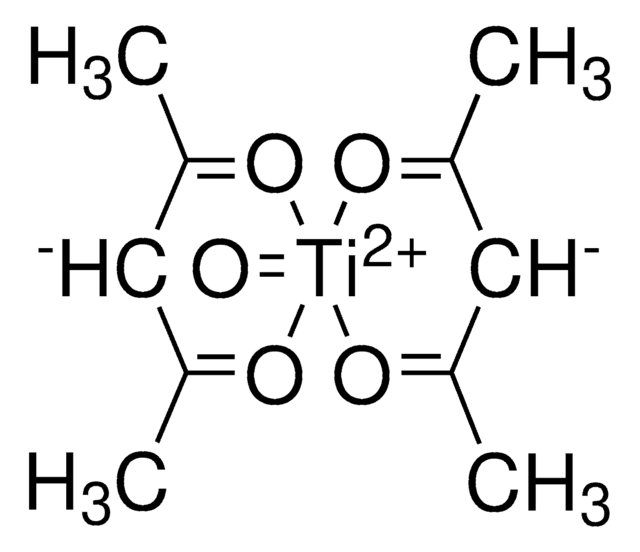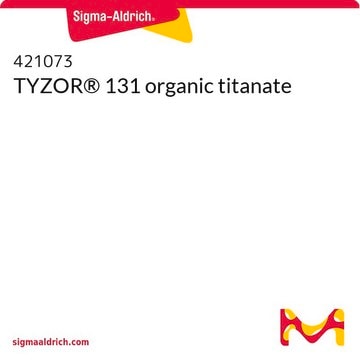333484
Titanium(IV) 2-ethylhexyloxide
95%
Synonim(y):
Tetra(2-ethylhexyl)titanate, Tetrakis(2-ethylhexyl) orthotitanate, TYZOR® TOT organic titanate
About This Item
Polecane produkty
Poziom jakości
Próba
95%
Postać
liquid
liquid
przydatność reakcji
core: titanium
reagent type: catalyst
współczynnik refrakcji
n20/D 1.479 (lit.)
tw
248-249 °C/11 mmHg (lit.)
gęstość
0.927 g/mL at 25 °C (lit.)
ciąg SMILES
CCCCC(CC)CO[Ti](OCC(CC)CCCC)(OCC(CC)CCCC)OCC(CC)CCCC
InChI
1S/4C8H17O.Ti/c4*1-3-5-6-8(4-2)7-9;/h4*8H,3-7H2,1-2H3;/q4*-1;+4
Klucz InChI
KTXWGMUMDPYXNN-UHFFFAOYSA-N
Szukasz podobnych produktów? Odwiedź Przewodnik dotyczący porównywania produktów
Informacje prawne
Hasło ostrzegawcze
Warning
Zwroty wskazujące rodzaj zagrożenia
Zwroty wskazujące środki ostrożności
Klasyfikacja zagrożeń
Eye Irrit. 2 - Skin Irrit. 2 - STOT SE 3
Organy docelowe
Respiratory system
Kod klasy składowania
10 - Combustible liquids
Klasa zagrożenia wodnego (WGK)
WGK 2
Temperatura zapłonu (°F)
159.8 °F - closed cup
Temperatura zapłonu (°C)
71 °C - closed cup
Środki ochrony indywidualnej
Eyeshields, Faceshields, Gloves, type ABEK (EN14387) respirator filter
Certyfikaty analizy (CoA)
Poszukaj Certyfikaty analizy (CoA), wpisując numer partii/serii produktów. Numery serii i partii można znaleźć na etykiecie produktu po słowach „seria” lub „partia”.
Masz już ten produkt?
Dokumenty związane z niedawno zakupionymi produktami zostały zamieszczone w Bibliotece dokumentów.
Klienci oglądali również te produkty
Produkty
Mesoporous materials, such as aerogels, offer advantages for practical hydrogen storage. They have large surface areas, open porosity, small pore sizes, and the ability to coat the surface with one or more compounds.
Titanium dioxide applications: Semiconducting material characteristics and diverse functionalities.
Nasz zespół naukowców ma doświadczenie we wszystkich obszarach badań, w tym w naukach przyrodniczych, materiałoznawstwie, syntezie chemicznej, chromatografii, analityce i wielu innych dziedzinach.
Skontaktuj się z zespołem ds. pomocy technicznej











